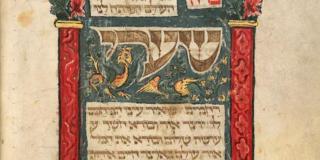
Ketubbah from Casale Monferrato
Unknown illustrator
Ketubbah
Manuscript on paper
Casale Monferrato, 1630
Marriage is a cornerstone of the Jewish way of life, and the celebration of this event is one of the most meaningful and joyful customs in Judaism. The ketubbah (marriage certificate) is a central document cementing the event. Traditionally, the bride would keep the document for the entire span of her life, which is why so many ketubbot are still preserved around the world today. However, the earliest ketubbot are a great rarity.
The Dorot Jewish Division maintains an important collection of more than 30 decorated ketubbot from around the world, representing different Judaic traditions and local Jewish art. While many ketubbot produced in the 18th century and later can be found in various archival repositories, examples from the 14th to 17th century are rare. The earliest ketubbot in the Library’s collection were handmade in northern Italy (Casale Monferrato, 1630, and Mantua, 1638), the most influential area of the Italian ketubbah’s school of ornamentation.
The intricate border surrounding the text in this ketubbah from Casale Monferrato depicts an inner joyful life, and its ornamentation shows the influence of the Italian Renaissance. The large (49 x 35 cm), exuberantly decorated manuscript demonstrates the richness of the families united by the marriage ceremony. Numerous creatures inhabit its border, from cherubs and other human-like figures to birds and butterflies, with details of vases and flowers. Stars of David decorate the four corners of the manuscript, and the center of the upper margin features a medallion with two hands in priestly blessing along with the tree of life.
This object can be displayed in an image on the exhibition website. Use the Official Image field to upload an image. Use the Copyright Status as the Official Image Rights Statement. If present in your search result, Use the Copyright Notice as the Official Image Copyright Notice.






